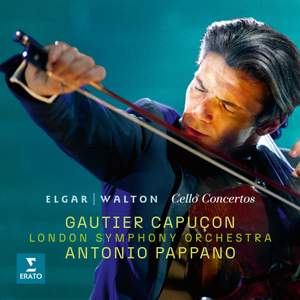Gautier Capuçon releases Edward Elgar’s Cello Concerto in E minor, op.85, coupled with William Walton’s Cello Concerto, recorded with the London Symphony Orchestra, conducted by Antonio Pappano.
“For me, the Elgar Cello Concerto is about passion,” says Gautier Capuçon, who has now recorded the work with the London Symphony Orchestra – which played at the Concerto’s premiere in 1919 – and its new Music Director, Antonio Pappano. The companion piece for the Elgar is William Walton’s Cello Concerto, premiered nearly 40 years later in 1957. “The Elgar is the quintessence of deep emotions, and the cello is exactly the right instrument to transmit them,” continues Capuçon. “The Walton Cello Concerto is absolutely gorgeous, a magical piece … It’s very challenging, very difficult. There are the two cadenzas, which are very demanding on the cellist, and like the Elgar, structurally, the second movement is an extremely virtuosic dialogue with the orchestra.” As Antonio Pappano explains, “This is not the first time the Elgar, which is a very strong, dark piece, has been paired with the Walton, and it’s a wonderful coupling. Walton uses a richer harmonic palette, a more diverse orchestra, more colourful forces: vibraphone, celesta, harp. The music twinkles and has the mystery of the night about it. But it sings. It sings the way Elgar’s concerto sings. At the end of the day it is a mood piece, and I think it shares that with the Elgar. And you can see the history of English music and how it progressed. I believe English music really has a lot to say if it’s done with full-on intensity and drama, and the London Symphony Orchestra can produce that like no other.”
Pappano comments on the repertoire : “Written in 1919, in the aftermath of World War I, Elgar’s cello concerto is mainly contemplative and although it has stormy episodes. It’s a very strong piece. It’s a very dark piece” – on Walton : “it’s more overtly virtuosic for the cello, has cadenzas, big cadenzas, where the cello is left alone to really show what he can do. But it is a mood piece. At the end of the day, it is a mood piece. And I think it shares that with Elgar”.





